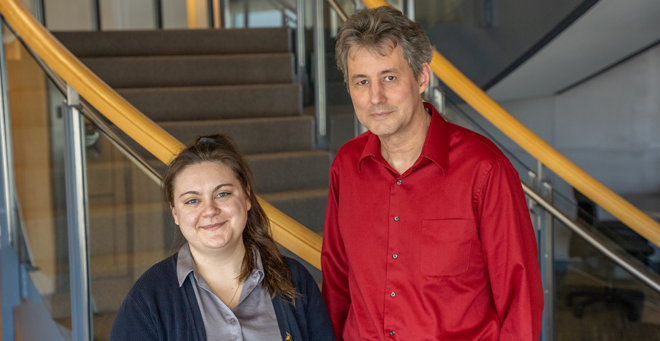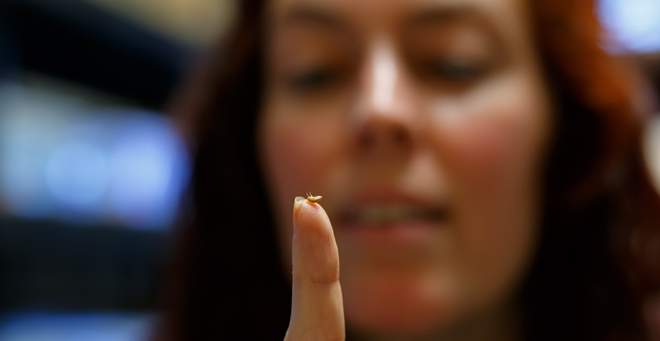
Scientists at UMass Chan Medical School and the Marine Biological Laboratory at Woods Hole have identified the first gene—Bmal1—to play a crucial role in regulating circatidal behavior in the crustacean Parhyale hawaiensis. Circatidal rhythms help animals cope with the rise and fall of the tides in coastal areas.
Published in Current Biology, the study by neurobiologists Patrick Emery, PhD, Joshua Rosenthal, PhD, and colleagues demonstrates the first molecular link between circatidal and circadian clocks, while establishing P. hawaiensis as a powerful new animal system for studying the genetics underlying circatidal rhythms.
“Biological clocks are critical for organisms—including humans—to optimize their physiology and adapt their behavior to environmental cycles,” said Dr. Emery, vice chair and professor of neurobiology at UMass Chan Medical School and a Marine Biological Laboratory Whitman Center investigator. “By understanding how these behaviors are genetically hardwired into organisms, we can map the sensory systems and neural circuits that impact physiology and behavior.”
Tides occur every 12.4 hours. One of the two daily tides is caused by the gravitational pull of the moon on the Earth, while the second results from the centrifugal force created by the moon and Earth’s rotational movements in space. Marine animals that live in tidal areas have adapted behaviors to contend with these dramatic shifts from dry to aquatic environments every 12.4 hours.
Though circatidal rhythms were first observed in the early 20th century in the Roscoff worm (Symsagittifera roscoffensis) and studied in detail in crabs, mussels and other marine species since the 1950s, the molecular and genetic underpinnings of the circatidal clock, as well as its relationship to the circadian clock, has remained elusive.
“The lack of an animal model amendable to genetic knockdown and transgenic manipulations has prevented scientists from definitively investigating the molecular origins of the circatidal clock and its relation to circadian clock genes,” said Emery. “Only a handful of studies about circatidal genetics exist and these are unable to either rule in or rule out a role for circadian clock genes in circatidal behaviors in animals.”
Erica Kwiatkowski, an MD/PhD student in the Emery lab at UMass Chan, in collaboration with the lab of Dr. Rosenthal, senior scientist at the Marine Biological Laboratory, identified the small amphipod crustacean P. hawaiensis as a promising model. To simulate P. hawaiensis’ natural environment, the researchers developed an artificial tidal habitat in the lab for the one-centimeter-long animal using artificial seawater that was pumped in and out of an aquarium every 12.4 hours.
Kwiatkowski and colleagues exposed the amphipods to 10 cycles (the equivalent of five days) in the artificial tidal environment. Once acclimated to these conditions, P. hawaiensis was removed by the researchers from the artificial tidal environment and placed into a habitat with a constant water level. While in individual test tubes, the animals’ swimming activity was recorded using infrared beams. Strikingly, every 12.4 hours, the majority of the animals (80 percent) increased their swimming activity in anticipation of high tides and then reduced activity in anticipation of low tide, even though they no longer were exposed to changing water levels. This demonstrated the existence of a circatidal clock controlling locomotor behavior in P. hawaiensis.

The lab of Marine Biological Laboratory director, Nipam Patel, PhD, has developed P. hawaiensis as a model organism for studying genes controlling numerous aspects of embryo development, including limb patterning. “Over the years, the Patel lab created valuable resources in this organism, such as a sequenced genome and methods to knock-out genes using CRISPR. Although the original intention wasn't to use Parhyale for the study of circatidal rhythms, it has turned out to be excellent for this purpose. We predict that this organism will catalyze a lot of future research in this area,” Rosenthal said.
Once the strong presence of a circatidal rhythm in P. hawaiensis was established, Kwiatkowski and colleagues used CRISPR/Cas9-guided gene knockdown to hunt for genes connected to the circatidal behavior. By knocking down individual genes, scientists can observe the effect that a lost gene has on a biological process.
Using the genes that control circadian rhythms in mammals as a guide to looking for circatidal genes, Kwiatkowski and colleagues found that knocking down the circadian gene Bmal1 changed P. hawaiensis behavior—the animal no longer exhibited circatidal swimming behaviors. Instead, the animals exhibited arhythmic behavior unconnected to tidal flows.
“Bmal1 is a critical component for the maintenance of circatidal behavior in P. hawaiensis,” said Kwiatkowski. “This is the first evidence that a gene involved in circadian rhythms is also involved in circatidal rhythms. This establishes a molecular link between the two systems.”
The next step for Emery and colleagues is to investigate the exact role Bmal1 plays in driving circatidal behavior and which other genes may be involved.
